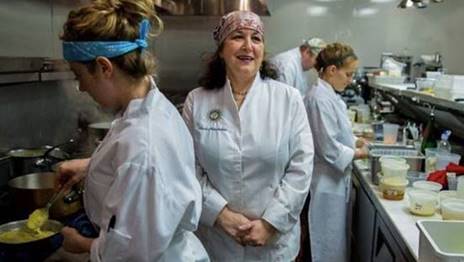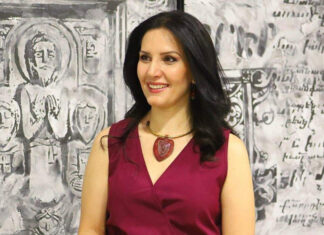Food and wine writer, blogger and cookbook author Barbara Hansen’s interview with acclaimed Armenian-American chef Carrie Nahabedian first appeared in the Los Angeles Times on December 8, 1999, and is reprinted with the permission of the Los Angeles Times. Nahabedian, best known for her work at the one-Michelin star restaurant NAHA in Chicago, was a recipient of a James Beard Foundation Award in 2008. As of the 2012 edition of the Michelin Guide, Nahabedian is one of only ten female chefs in the United States to hold a Michelin star. Nahabedian and her restaurateur cousin, Michael Nahabedian, opened NAHA in November 2000 in Chicago. The Mediterranean-inspired American cuisine earned a Michelin Star for eight consecutive years, a James Beard Award for “Best Chef, Great Lakes,” and four stars by Phil Vettel-the highest rating given by the legendary Chicago Tribune critic. For 18 years, Nahabedian’s NAHA was a mainstay among the city’s top restaurants. In April of 2013, Carrie and Michael opened Brindille-French for “twig”-offering refined Parisian cuisine, a celebration of their love of French culinary traditions, techniques and flavors. Hailed as the “Best Restaurant to Open in 2013” by the Chicago Tribune, Brindille was awarded the James Beard Foundation Award for “Outstanding Restaurant Design, 2015” for the work of Tom Nahabedian and Bureau of Architecture and Design.
A James Beard Award winner herself, Barbara Hansen wrote food and restaurant articles for The Los Angeles Times, where she was on staff for many years. She has two blogs, www.tableconversation.com and www.eatmx.com, that is devoted to Mexican food, and has written for Bon Appetit, Saveur and other publications. Her six books include a best seller, Mexican Cookery, two Southeast Asian cookbooks, a book on bread and a guide to Korean restaurants in Los Angeles.
(For the original story, see: https://www.latimes.com/archives/la-xpm-1999-dec-08-fo-41602-story.html).
LOS ANGELES — In Carrie Nahabedian’s mid-Wilshire townhouse, a broad coffee table is covered with mezze. One plate holds yalanchi, rice-stuffed grape leaves sprinkled with fresh mint leaves. Another contains the garbanzo bean dip hummus, streaked with rivulets of golden olive oil. Crackers and grilled triangles of pita bread go with the dip. String cheese, Greek olives and thin slices of basturma (seasoned dried beef) share a platter, and a shallow bowl contains huge, glistening red prunes, pistachios, cashews, raisins and large Medjool dates.
Enough, right?
Not for Nahabedian. She brings out cheese boeregs, which are pastries stuffed with feta, cottage and Kefalotiri cheeses. Just out of the oven and made with fresh filo dough, they’re unbelievably light and flaky.










